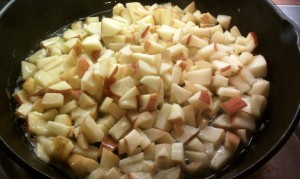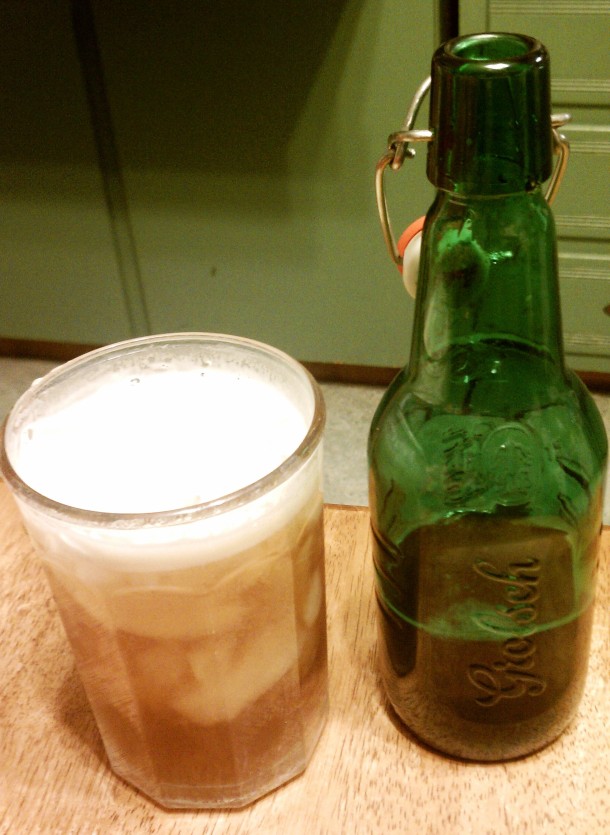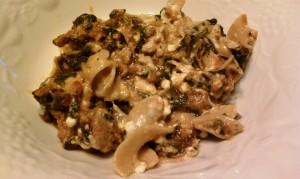
Finished Kombucha in Jar with SCOBY
Kombucha! Have you had it before or are you wondering what I am talking about?
Wikipedia states that: Kombucha is a tea-based beverage that is often drunk for its anecdotal health benefits or medicinal purposes. Kombucha is available commercially and can be made at home by fermenting tea using a visible, solid mass of yeast and bacteria which forms the kombucha culture, often referred to as the “mushroom” or the “mother”.
If you have ever bought kombucha, then you know that a 16 oz. bottle runs anywhere from $2 to $3. So, the motivation for making it at home is purely financial for me.
It is a taste that some people love and some hate. I love it and so do the kids, but Mike hates it. Fine, more for us! If I had to describe its taste, I would say it is similar to hard apple cider. It is effervescent, and since we don’t give the kids soda, it gives them a fizzy treat. They do prefer the ones that I have flavored with a bit of grape juice to the plain stuff. As a family, we drink about 1 gallon a week, but only because that is all I have been making. We are doubling our production to 2 gallons a week soon.
I am not going to list the health benefits of kombucha here, but it does contain a lot of B Vitamins and is a good source of probiotics for folks that want to stay away from dairy sources such as yogurt. Just google “kombucha + health” and you can spend days reading conflicting opinions on it. By the way, here is a video from Barbara Allan about kombucha and probiotics. She and I went to college together 20+ years ago at The University of Alabama and both lived in the same dorm. Later, she battled arthritis and used diet to overcome that.
There are three phases to making your own homemade kombucha. They are: growing the SCOBY (Symbiotic Culture of Bacteria and Yeast) also know as the mother or mushroom, brewing and fermenting the tea, and bottling and double or 2nd fermentation.
GROWING THE SCOBY
You get to skip this part if someone has given you a SCOBY. I was not that lucky. I made my SCOBY in an old well-washed glass peanut butter jar. I let it sit in the cabinet for about 3 weeks and it was about 1/2 inch thick by then. Here are a few pictures of a new one I am growing at 3 and 5 days old. In the last picture, you can see the new daughter that will form on top of the mother in your fermenting jar once you start making the kombucha.

You will find detailed instructions on making your own kombucha SCOBY from a bottle of the store-bought stuff at Food Renegade and here is a video about doing it. I used those as my guide.
Basically, take a clean glass jar and pour in about 8 – 12 ounces or RAW UNFLAVORED storebought kombucha into it. Put a clean breathable membrane over the top, such as cheese cloth, a kitchen towel or even a paper towel and hold it down with a rubber band. Put the jar in an out of the way cabinet or pantry and leave it alone for 2-3 weeks. It will grow faster when it is hotter such as in the summer and slower during the winter since it will be colder.
BREWING AND FERMENTING THE TEA
Once you have your SCOBY, to brew kombucha at home you need four ingredients: a large food-safe glass jar, clean water, sugar, and black and/or green tea. Yes, I know, you don’t keep lots of white sugar around anymore, but this will be eaten by the SCOBY, not by you. I have used both plain white sugar and “sugar in the raw” with success. Do not use any kind of artificial sweetener (even stevia is a no-no) as the SCOBY actually needs something to eat. Some people have used pasteurized (not raw) honey with limited success, but the closer it is to pure sugar, the better.
Black and green tea are the best options for the tea. Red or rooiboos tea can be used for part of it, but not all. The SCOBY has developed to process real tea, meaning leaves from the Camellia sinensis plant and that is what works best. You also need to steer away from flavored teas as they can hurt your SCOBY. For example, the bergamot oil in Earl Grey tea will damage your SCOBY. Don’t worry, you can always flavor your kombucha after you have removed your SCOBY during the 2nd fermentation once it is bottled. Also, organic is always a good choice for your tea. Just because of what I have on-hand, I used organic green tea and conventional black tea.

When making kombucha, it is important to not contaminate your brew. So, you want to make sure everything is very clean. But, traces of soap on your equipment is bad for the SCOBY, so wash everything well and make sure it is soap-free. Also, make sure your hands and any spoons, funnels, etc. you are using are clean.
Boil about 1 gallon of water in a pot, I use my dutch oven. When it is boiling, add 1 cup of sugar and let it dissolve. Then turn off the heat and add your tea bags. I used 2 family-size black tea bags and about 4 regular green tea bags. Let it steep for at least 5-10 minutes and then remove the tea bags. Let the tea cool to room temperature. To prevent contamination, I cover mine with the dutch oven lid.
Once cool, pour the tea into your 1 gallon glass jar. I bought one for about $5 that was billed as a “cracker jar“. You do not need a lid so if you can find a used food-grade glass jar for free, great. After you put the tea in, add your SCOBY and the kombucha liquid it has been growing in. Each time you make kombucha, you will need to save about 1/2 to 1 cup of liquid from your last batch to add with the SCOBY. This helps keep the environment acidic and prevents mold growth.
Put a piece of clean breathable membrane over the top of the jar, such as cheese cloth, part of a kitchen towel or even a paper towel and hold it down with a rubber band. Put it in a dark place where it can sit undisturbed. A cabinet or pantry is usually a good choice. Wait anywhere from 5-10 days and you will have kombucha. The kombucha ferments faster in the summer when warm and slower in the winter when cold. Once you have enjoyed kombucha, you will recognize the slightly vinegary scent that lets you know it is ready. Or, you can invest in pH test strips and test it, if you feel the need.
BOTTLING AND DOUBLE FERMENTATION
You can find a lot of information about double fermentation at Food Renegade’s blog. You will want to get some glass bottles with tight-fitting lids. You can use recycled kombucha bottles if you have them or you can get the bottles with a flip-top hinged cap, the kind that Grolsch beer often comes in. You can buy those at a beer brewing supply store or just do what we did and buy Grolsch beer and save the bottles.
The first step in bottling is taking care of your SCOBY. With clean hands, gently lift it out and put is on a clean plate or bowl. Save the 1/2 to 1 cup of kombucha that it will need. Set that aside.
The rest of your kombucha can now be bottled. For plain or original kombucha, all you do is pour the kombucha into a clean bottle (I filter mine with a small plastic sieve) and close the bottle. For flavored kombucha, you can add whatever you like at this point. Just look around the Internet or check out the ingredients of storebought kombucha for ideas. We typically add juice and/or ginger to ours. If you want to add juice, put 1 oz. of juice into your clean bottle and then add 14-15 oz. of kombucha on top and close the bottle.
Place the closed bottles in a warm dark place for 2-5 days and then refrigerate until ready to enjoy. The ones with juice (AKA sugar water) added will get fizzy faster. So, I would give the plain or ginger ones longer then the juice ones. Always be careful when you open a bottle of kombucha as they are pressurized. Open it very carefully and enjoy.

You say “but you are talking about fermentation, so isn’t kombucha alcoholic?” Well, it can be, but not under the conditions I have given here. If you add a lot of something sugary, such as juice to the kombucha before the 2nd fermentation and then allow it to ferment at room temperature for a long time, yes you will create some alcohol. But, normally kombucha contains less than 0.5% alcohol, which classifies kombucha as a non-alcoholic beverage. Typically, our 2nd ferment is only a couple of days, just enough to get a little fizz, so it is not a problem.
– Stacey
NOTE: I am not an expert on the preparation of fermented items containing bacteria. I have just learned to make kombucha by reading about it and experimenting. Please only use my instructions as a guide. If you do something wrong and get sick, I am not responsible. You probably won’t, but I am just saying. The biggest concern is not being clean enough and getting some contamination. If you look on the web, you can find lots of pictures of what a healthy SCOBY looks like and what a moldy one does. If you are worried, just keep paying $3 a bottle for kombucha at the store.
 I reached the age of 40 never having heard of a “Dutch Baby”. The first time I heard about it was watching Melissa D’Arabian make a Vanilla Dutch Baby on her “Ten Dollar Dinners” show. I tried that recipe and liked it, but then I went looking for a healthier version with less flour, but the whole wheat kind and more eggs for protein.
I reached the age of 40 never having heard of a “Dutch Baby”. The first time I heard about it was watching Melissa D’Arabian make a Vanilla Dutch Baby on her “Ten Dollar Dinners” show. I tried that recipe and liked it, but then I went looking for a healthier version with less flour, but the whole wheat kind and more eggs for protein. 
































